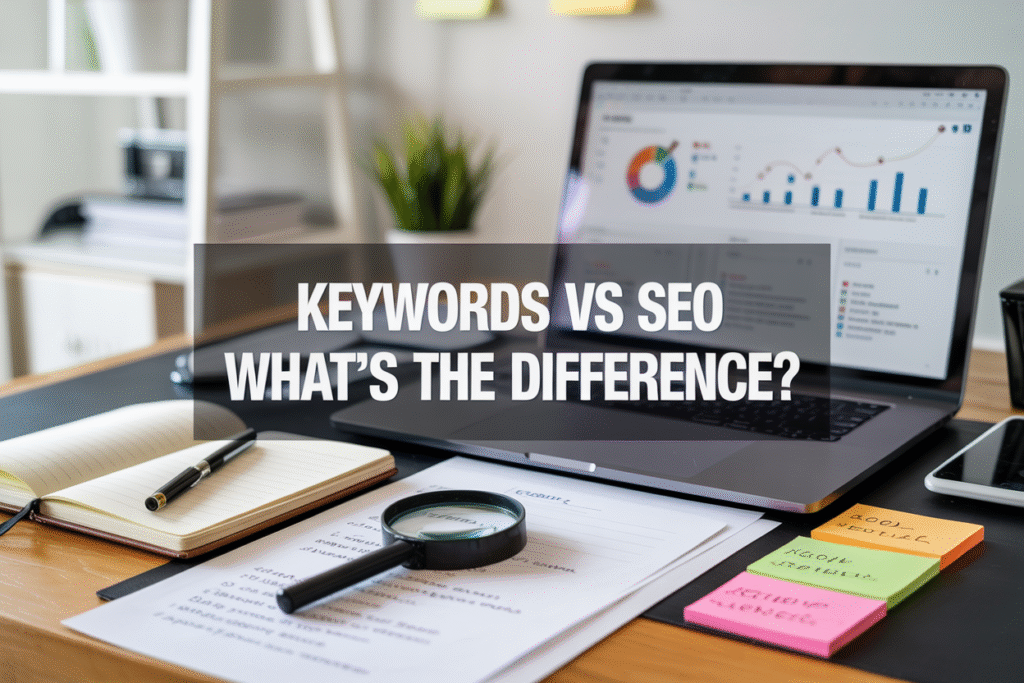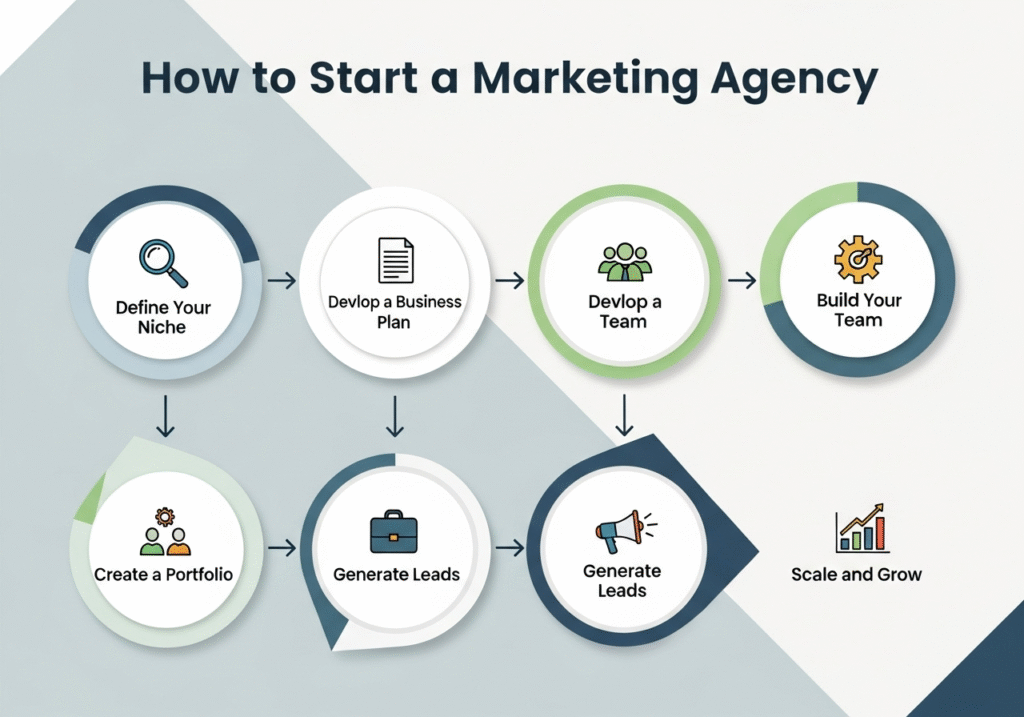Many beginners wonder “is keywords and SEO the same thing” when they first dive into digital marketing. The short answer is no – keywords are just one piece of the much larger SEO puzzle.
This guide is for complete beginners who want to understand how keywords fit into SEO strategy without getting overwhelmed by technical jargon. Whether you’re a small business owner, blogger, or someone curious about digital marketing, we’ll break down these concepts in simple terms.
We’ll explore what keywords actually are and how they differ from SEO as a whole, plus how these two work together to boost your website’s visibility. You’ll also discover the most common mistakes beginners make when trying to understand this relationship, so you can avoid the confusion that trips up most newcomers.
By the end, you’ll have a clear picture of where keywords fit into your overall SEO efforts and how to use this knowledge to improve your online presence.
Understanding Keywords and Their Role in Digital Marketing

What Keywords Are and Why They Matter
Keywords are the specific words and phrases people type into search engines when looking for information, products, or services. Think of them as the bridge between what someone wants to find and the content you’ve created. When someone searches for “best pizza near me” or “how to change a tire,” those exact phrases become the keywords that connect searchers to relevant websites.
The importance of keywords in digital marketing cannot be overstated. They represent actual human intent – real people searching for real solutions. Every keyword reveals what your potential audience cares about, what problems they’re trying to solve, and what information they need. This makes keywords incredibly valuable for understanding your market and creating content that actually matters to people.
Keywords also serve as the foundation for search optimization strategies. Search engines use these terms to understand what your content is about and whether it matches what someone is searching for. Without proper keyword strategy, even the most brilliant content might never reach its intended audience.
Different Types of Keywords You Should Know
Keywords come in several distinct categories, each serving different purposes in your digital marketing efforts. Understanding these types helps you create more effective content strategies.
Short-tail keywords consist of one to three words and typically have high search volumes but intense competition. Examples include “SEO,” “pizza,” or “marketing tips.” These keywords are broad and attract large audiences but can be difficult to rank for.
Long-tail keywords contain four or more words and are more specific. Phrases like “best SEO tools for small businesses” or “how to make gluten-free pizza dough” fall into this category. While they have lower search volumes, they often convert better because they match specific user intent.
Commercial keywords indicate buying intent, such as “buy running shoes online” or “cheap laptop deals.” These are gold mines for businesses because they attract people ready to make purchases.
Informational keywords show that someone wants to learn something. Terms like “what is SEO” or “how to lose weight” signal that users are in research mode rather than buying mode.
Branded keywords include company or product names, like “Nike shoes” or “iPhone 15.” These are crucial for businesses to monitor and optimize for.
How Keywords Connect Users to Your Content
The connection between keywords and content discovery works like a sophisticated matching system. When someone types a query into Google, the search engine scans billions of web pages to find content that best matches those specific terms and the searcher’s intent.
This process goes beyond simple word matching. Modern search engines analyze context, user behavior, and semantic relationships between words. If someone searches for “apple,” the search engine considers whether they mean the fruit, the technology company, or something else based on additional context clues.
Your content needs to speak the same language as your audience. If you’re writing about fitness but your audience searches for “workouts” while you only use “exercise routines,” you might miss valuable connections. This is why keyword research becomes so important – it reveals the actual words and phrases your audience uses.
The magic happens when your content naturally incorporates the terms people are searching for while providing genuine value. Search engines reward content that satisfies user intent, leading to higher rankings and more organic traffic.
Common Keyword Mistakes That Hurt Your Rankings
Many beginners fall into keyword traps that damage their search performance. One major mistake is keyword stuffing – cramming as many keywords as possible into content without regard for readability or natural flow. This approach backfires because search engines now prioritize user experience over keyword density.
Another common error is targeting keywords that are too competitive for your current authority level. New websites trying to rank for highly competitive terms like “SEO” or “digital marketing” often waste months of effort when they could succeed faster with less competitive alternatives.
Ignoring search intent represents another critical mistake. Someone searching for “buy coffee maker” has different needs than someone searching for “how coffee makers work.” Creating content that doesn’t match the searcher’s intent leads to high bounce rates and poor rankings.
Many people also make the mistake of focusing solely on high-volume keywords while ignoring long-tail opportunities. These longer, more specific phrases often convert better and face less competition, making them excellent starting points for building organic traffic.
Finally, failing to research what your actual audience searches for leads to content that sounds professional but doesn’t attract real visitors. Your industry jargon might not match how customers actually describe your products or services.
Breaking Down SEO and Its Core Components

What SEO Really Means for Your Website
SEO stands for Search Engine Optimization, and it’s basically the art and science of making your website visible to people searching online. Think of it as making your website speak Google’s language fluently. When someone types “best pizza near me” into Google, SEO determines whether your pizza shop shows up on the first page or gets buried on page 47 where nobody will ever find it.
Your website needs SEO to compete in today’s digital world. Without proper search optimization, even the most beautiful website with amazing content will remain invisible to potential customers. SEO helps search engines understand what your website is about, who it’s for, and why it deserves to rank higher than your competitors.
The goal isn’t just to get more traffic – it’s to attract the right kind of visitors who are genuinely interested in what you offer. Good SEO brings qualified leads to your doorstep, people who are actively searching for your products or services.
Technical SEO Elements That Drive Results
Technical SEO forms the foundation that everything else builds upon. Your website’s loading speed plays a huge role in rankings – Google prefers sites that load in under three seconds. Slow websites frustrate users and get penalized in search results.
Mobile responsiveness is non-negotiable. More than half of all searches happen on mobile devices, so your site must look and function perfectly on smartphones and tablets. Google actually uses mobile-first indexing, meaning it primarily looks at the mobile version of your site.
SSL certificates (the little lock icon in your browser) are essential for security and rankings. Clean URL structures help both users and search engines navigate your site easily. XML sitemaps act like roadmaps, guiding search engines to all your important pages.
Site architecture matters too. A well-organized website with clear navigation helps search engines crawl and index your content efficiently. Broken links, duplicate content, and crawl errors can seriously hurt your rankings.
Content Optimization Strategies That Work
Content optimization goes far beyond stuffing keywords into your text. Modern SEO requires creating genuinely valuable content that answers real questions people have. Search engines have gotten incredibly smart at recognizing quality content that helps users solve problems.
Your keyword strategy should focus on search intent – understanding why someone searches for specific terms. Are they looking for information, trying to buy something, or comparing options? Matching your content to search intent dramatically improves your chances of ranking well.
Title tags and meta descriptions are your first impression in search results. They need to be compelling enough to make people click while accurately describing your content. Header tags (H1, H2, H3) help organize your content and signal its importance to search engines.
Internal linking connects related pages on your website, helping search engines understand your site’s structure and keeping visitors engaged longer. Fresh, regularly updated content signals to search engines that your site is active and relevant.
Off-Page SEO Factors You Cannot Ignore
Off-page SEO happens outside your website but significantly impacts your rankings. Backlinks from other websites act like votes of confidence – the more high-quality sites that link to you, the more authority you build in Google’s eyes.
Social media signals, while not direct ranking factors, can amplify your content’s reach and generate more backlinks naturally. When people share your content on social platforms, it increases visibility and can lead to other websites linking to you.
Local SEO matters tremendously for businesses with physical locations. Google My Business listings, local citations, and positive reviews help you dominate local search results. Online reputation management affects both rankings and conversion rates.
Brand mentions, even without links, help establish your authority and relevance in your industry. Google considers how often your brand gets mentioned across the web when determining your site’s credibility.
How Search Engines Evaluate Your Website
Search engines use complex algorithms with hundreds of ranking factors to evaluate websites. They crawl your site regularly, following links and indexing new content. The crawling process determines what content gets included in search results.
User experience signals like bounce rate, time on page, and click-through rates influence rankings. Google pays attention to how people interact with your site after clicking through from search results. High-quality sites keep visitors engaged and coming back for more.
Relevance, authority, and trustworthiness form the foundation of how search engines rank websites. Relevance means your content matches what people search for. Authority comes from other reputable sites linking to you. Trustworthiness involves factors like security, accurate information, and positive user signals.
Search engines also consider freshness for time-sensitive topics, geographic relevance for local searches, and personalization based on individual search history. The evaluation process is continuous, with rankings fluctuating as algorithms update and competitors make improvements.
The Relationship Between Keywords and SEO Explained

How Keywords Function Within SEO Strategy
Keywords serve as the foundation of any effective SEO strategy, acting like bridges that connect what people search for with the content you create. When you understand keywords in SEO, you’re essentially learning the language your audience uses to find solutions online.
Search engines crawl your website looking for relevant terms and phrases that match user queries. Your keyword strategy determines how well search engines can understand and categorize your content. These terms appear in multiple places across your site – from title tags and meta descriptions to headers and body content.
The relationship works like this: when someone types “best running shoes for beginners” into Google, the search engine scans millions of pages to find content that best matches this query. If your page contains relevant keywords and provides valuable information about beginner running shoes, you have a better chance of appearing in search results.
Smart keyword placement involves more than just stuffing terms into your content. On page SEO requires strategic positioning of keywords in areas that matter most to search engines, including your page titles, first paragraphs, and subheadings. The goal is creating natural, readable content that genuinely helps users while signaling relevance to search algorithms.
Why Keywords Alone Cannot Guarantee Success
Many beginners mistakenly believe that finding the perfect keywords automatically leads to top search rankings. This oversimplified view of SEO vs keywords often leads to disappointment and wasted effort.
Search engines have evolved far beyond simple keyword matching. Google’s algorithms now consider hundreds of ranking factors, including page loading speed, mobile responsiveness, user engagement metrics, and content quality. You might have perfectly optimized keywords, but if your website takes ten seconds to load or provides a poor user experience, you’ll struggle to rank well.
Search optimization requires a holistic approach that balances keyword relevance with technical performance and user satisfaction. Your content must genuinely answer user questions and provide value beyond keyword placement. Search engines can detect when content is written primarily for algorithms rather than humans, often penalizing such practices.
User behavior signals play a crucial role too. If visitors quickly leave your page after arriving (high bounce rate) or don’t engage with your content, search engines interpret this as a sign that your page doesn’t meet user expectations, regardless of your keyword optimization.
The Bigger Picture of Search Engine Optimization
Understanding what is SEO means recognizing that keywords are just one piece of a much larger puzzle. SEO encompasses technical website optimization, content creation, link building, user experience design, and ongoing performance analysis.
SEO basics include ensuring your website structure makes sense to both users and search engines. This involves creating logical navigation, optimizing images, implementing proper schema markup, and maintaining fast loading speeds across all devices. These technical elements work alongside your content strategy to create a comprehensive optimization approach.
The modern SEO landscape also emphasizes expertise, authority, and trustworthiness (E-A-T). Search engines favor websites that demonstrate deep knowledge in their field, earn citations from reputable sources, and maintain consistent, accurate information. Your keyword research should align with topics where you can genuinely provide expert insights.
Content freshness and regular updates signal to search engines that your website remains active and relevant. This ongoing commitment to quality content creation, combined with strategic keyword usage, creates the sustainable growth that defines successful SEO campaigns.
Social signals, local optimization, and voice search compatibility represent additional layers of modern SEO that extend far beyond traditional keyword strategies. The most successful websites integrate keywords naturally within comprehensive optimization strategies that prioritize user experience above all else.
Key Differences That Separate Keywords from SEO

Scope and Complexity Comparison
Keywords represent just one piece of the digital marketing puzzle, while SEO encompasses an entire ecosystem of strategies and techniques. Think of keywords as individual building blocks – specific words or phrases that people type into search engines. They’re concrete, tangible, and relatively straightforward to understand.
SEO, on the other hand, is like constructing an entire building with those blocks. It involves technical website optimization, content strategy, user experience design, link building, local search optimization, mobile responsiveness, page speed optimization, and much more. While you can learn basic keyword research in a few hours, mastering SEO takes months or even years of continuous learning and practice.
| Aspect | Keywords | SEO |
|---|---|---|
| Learning Curve | Beginner-friendly | Complex, ongoing education required |
| Focus Area | Specific search terms | Holistic website optimization |
| Implementation | Direct application in content | Multi-layered strategy execution |
Time Investment Required for Each
Keyword research can be accomplished relatively quickly once you know the basics. You can identify relevant keywords for your business in a matter of hours or days using various research methods and tools. The process involves understanding your audience, analyzing competitor keywords, and selecting terms that match your content goals.
SEO demands a much longer commitment. Building authority and seeing meaningful results typically takes 3-6 months minimum, with many campaigns requiring 12+ months to reach their full potential. Search engines need time to crawl, index, and evaluate your optimized content. Building quality backlinks, improving site architecture, and establishing domain authority are gradual processes that can’t be rushed.
The ongoing nature of SEO also means continuous time investment. Search algorithms change regularly, competitor landscapes shift, and user behavior evolves. Successful SEO requires consistent monitoring, updating, and refinement of strategies.
Measurable Outcomes and Results
Keywords offer straightforward, quantifiable metrics that beginners can easily track and understand. You can measure keyword rankings, search volume, keyword difficulty scores, and click-through rates for specific terms. These metrics provide clear snapshots of how individual keywords perform.
SEO metrics paint a broader picture of overall website performance. You’ll track organic traffic growth, domain authority improvements, conversion rates, bounce rates, page load speeds, and user engagement metrics. While these measurements are more complex, they provide deeper insights into business impact.
SEO results also tend to compound over time, creating exponential growth rather than linear improvements. A single optimized page can rank for hundreds of related keywords, generating traffic far beyond what individual keyword targeting might achieve.
Tools and Resources Needed
Getting started with keyword research requires minimal investment. Free tools like Google Keyword Planner, Ubersuggest’s free tier, and Answer The Public can provide substantial keyword insights. Even basic spreadsheet software helps organize and analyze keyword data effectively.
Comprehensive SEO campaigns benefit from more sophisticated toolsets. Professional SEO platforms like SEMrush, Ahrefs, or Moz offer technical auditing capabilities, backlink analysis, competitor research, and performance tracking across multiple metrics. These tools often require monthly subscriptions ranging from $100-500+ depending on features needed.
SEO also demands diverse skill development and resources. You might need web development knowledge for technical fixes, content creation skills for optimization, graphic design capabilities for visual elements, and analytical skills for performance interpretation. Many businesses invest in SEO training, courses, or professional services to bridge these knowledge gaps effectively.
How Keywords and SEO Work Together for Maximum Impact

Creating Keyword-Optimized Content That Ranks
Creating content that both readers and search engines love starts with understanding user intent behind each keyword. When you know why someone searches for “keyword strategy,” you can craft content that directly answers their questions while naturally incorporating related terms.
Start by mapping your keywords to specific content topics. If you’re targeting “SEO basics,” create comprehensive guides that cover fundamental concepts without keyword stuffing. Your primary keyword should appear in the title, first paragraph, and throughout the content where it makes sense contextually.
Structure your content with clear headings that include variations of your target keywords. This helps search engines understand your content’s hierarchy while making it easier for readers to scan and find relevant information.
Internal linking plays a crucial role here. Connect your keyword-optimized content to other relevant pages on your site, creating a web of interconnected topics that strengthens your overall SEO performance.
Building SEO Strategy Around Keyword Research
Your keyword research forms the foundation of every successful SEO campaign. Start by identifying seed keywords related to your business, then expand into long-tail variations that match specific user queries.
Use tools like Google Keyword Planner or SEMrush to discover search volumes, competition levels, and related terms. Look for keywords with decent search volume but manageable competition – these sweet spots offer the best opportunities for ranking.
Group your keywords into clusters based on search intent and topic relevance. This clustering approach allows you to create comprehensive content that targets multiple related keywords while maintaining topical authority.
Consider seasonal trends and emerging topics in your industry. Keywords that spike during certain periods can drive significant traffic when you time your content creation properly.
Balancing Keyword Usage with User Experience
The days of cramming keywords into every sentence are long gone. Modern SEO requires a delicate balance between optimization and readability. Your content should flow naturally while still signaling relevance to search engines.
Focus on semantic variations rather than exact keyword repetition. If your target keyword is “search optimization,” use related terms like “SEO improvement,” “ranking enhancement,” and “search visibility” throughout your content.
Pay attention to keyword density – aim for 1-2% of your total word count for primary keywords. More important than density is natural placement. Keywords should appear where they make grammatical and contextual sense.
User experience signals like bounce rate, time on page, and click-through rates directly impact your rankings. If visitors quickly leave your page because it reads like spam, your keyword optimization efforts backfire.
Measuring Success When Combining Both Approaches
Track your keyword rankings alongside comprehensive SEO metrics to gauge true performance. Rising keyword positions mean nothing if they don’t translate to increased traffic and conversions.
Monitor organic traffic growth for your target keywords using Google Analytics. Look for trends in both branded and non-branded keyword traffic to understand how your combined approach affects visibility.
Set up conversion tracking to measure how keyword-optimized content contributes to your business goals. Whether that’s email signups, product purchases, or lead generation, connect your SEO efforts to real outcomes.
Use tools like Google Search Console to identify which keywords drive the most impressions and clicks. This data reveals opportunities to optimize existing content and guides future keyword targeting decisions.
Regular SEO audits help you spot technical issues that might undermine your keyword optimization efforts. Page speed, mobile responsiveness, and crawlability all impact how well your keyword-focused content performs in search results.
Common Misconceptions Beginners Have About Keywords and SEO

Why More Keywords Does Not Mean Better Rankings
Stuffing your content with keywords won’t magically shoot you to the top of Google’s results. This myth leads many beginners to cram their articles with awkward keyword repetitions that make content nearly unreadable.
Search engines have evolved far beyond simple keyword counting. Google’s algorithms now prioritize user experience, content quality, and natural language patterns. When you overload your pages with keywords, you’re actually hurting your SEO performance rather than helping it.
Modern search engines can detect keyword stuffing and will penalize your site for it. Instead of focusing on quantity, concentrate on creating valuable content that naturally incorporates your target keywords. A single well-placed keyword that flows naturally with your content performs better than ten forced mentions.
| Approach | Result |
|---|---|
| Keyword stuffing | Penalties, poor user experience |
| Natural keyword use | Better rankings, engaged readers |
Smart SEO basics involve understanding that search optimization works best when keywords feel organic within your content. Quality beats quantity every time in today’s search landscape.
The Truth About Keyword Density Myths
The old “2-3% keyword density” rule that many beginners cling to is outdated and potentially harmful. This misconception suggests that maintaining a specific percentage of keywords throughout your content guarantees better rankings.
Google stopped caring about exact keyword density percentages years ago. Instead, the focus shifted to semantic search and user intent. Your keyword strategy should revolve around answering user questions comprehensively rather than hitting arbitrary percentage targets.
What matters now is topical relevance and context. Search engines analyze the entire content piece, looking for related terms, synonyms, and comprehensive coverage of topics. This approach, called Latent Semantic Indexing (LSI), rewards content that covers subjects thoroughly.
Here’s what actually impacts your on page SEO:
- Content depth and comprehensiveness
- Natural language flow
- User engagement metrics
- Related keyword variations
- Clear content structure
Stop counting keyword percentages and start thinking about whether your content genuinely helps readers. This shift in mindset will improve both your search optimization efforts and user satisfaction.
Understanding Why SEO Takes Time to Show Results
Expecting immediate results from SEO efforts sets beginners up for disappointment and poor decision-making. Unlike paid advertising, organic search optimization follows a gradual timeline that can’t be rushed.
Search engines need time to crawl, index, and evaluate your content changes. Google’s algorithms assess hundreds of ranking factors, including content quality, user behavior signals, and site authority. This comprehensive evaluation process naturally takes weeks or months to complete.
Several factors influence your SEO timeline:
Content Competition: Highly competitive keywords require more time to rank
Site Authority: New websites need longer to build trust with search engines
Content Quality: Exceptional content may rank faster than average material
Technical Issues: Site problems can delay ranking improvements
Most SEO campaigns show initial movement within 3-6 months, with significant results appearing after 6-12 months of consistent effort. This timeline isn’t a flaw in your SEO guide approach – it’s how the system works.
Patience pays off because organic rankings, once achieved, tend to be more stable than paid advertising results. Building sustainable search visibility requires time, but the long-term benefits make the wait worthwhile. Focus on creating valuable content and maintaining consistency rather than expecting overnight success.

Keywords and SEO work as partners, not as the same thing. Keywords are the specific words and phrases people type into search engines, while SEO is the bigger picture strategy that includes keywords along with technical optimization, content quality, and user experience. Think of keywords as one important tool in your SEO toolbox, but not the entire toolbox itself.
Getting this relationship right makes all the difference for your website’s success. Start by researching the keywords your audience actually uses, then build your SEO strategy around those insights. Don’t fall into the trap of keyword stuffing or thinking that ranking for keywords alone will solve all your traffic problems. Focus on creating valuable content that naturally incorporates your target keywords while also paying attention to site speed, mobile optimization, and overall user experience. This balanced approach will give you the best shot at ranking well and attracting the right visitors to your site.
FAQs
Do keywords alone determine SEO success?
No, keywords alone do not determine SEO success. While keywords are essential for telling search engines what your content is about, SEO includes many other factors like backlinks, site speed, mobile optimization, and content quality.
Can ignoring SEO harm keyword performance?
Yes. Even if you choose the perfect keywords, ignoring SEO strategies can prevent your pages from ranking well. Keywords need SEO support to reach the top positions in search results.
Is “is keywords and SEO the same thing” a common misconception?
Absolutely. Many beginners think using the right keywords is all you need for SEO, but in reality, keywords are just one component of a complete SEO strategy.
Should I focus more on keywords or SEO?
Both are important. Keywords guide your content creation, while SEO ensures your site can rank effectively for those keywords. Balancing both gives the best results.
Can keywords improve SEO if used correctly?
Yes. Properly researched and naturally placed keywords enhance SEO by helping search engines understand your content, improving relevancy, and attracting the right audience.
Does SEO include long-tail keywords?
Definitely. Long-tail keywords are part of SEO because they target specific search intent, increase the chances of ranking, and drive more qualified traffic.
Can too many keywords hurt SEO?
Yes. Overusing keywords, known as keyword stuffing, can harm your rankings. SEO works best when keywords are integrated naturally and meaningfully.
Do comments or user engagement affect SEO with keywords?
Yes. Engagement like comments can add fresh content and context around your keywords, signaling activity and relevance to search engines.
How often should I update keywords for SEO?
Regularly. Search trends change, so updating your keywords helps maintain relevance and keeps your SEO strategy aligned with current user search behavior.
Why is it important to understand that keywords and SEO are not the same thing?
Understanding the difference prevents beginner mistakes like overstuffing keywords or ignoring technical SEO. Knowing how they work together ensures your site can rank effectively while attracting the right audience.



